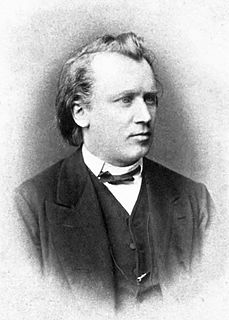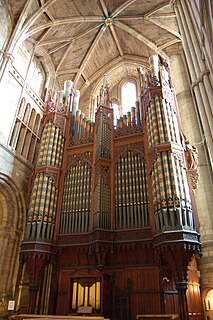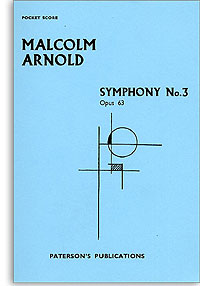Related Research Articles
Robert Wilfred Levick Simpson was an English composer and long-serving BBC producer and broadcaster.

The Symphony No. 5 in B-flat major, WAB 105, by Anton Bruckner was written in 1875–1876, with minor changes over the next two years. It came at a time of trouble and disillusion for the composer: a lawsuit, from which he was exonerated, and a reduction in salary. Dedicated to Karl von Stremayr, education minister in the Austro-Hungarian Empire, the symphony has at times been nicknamed the "Tragic", the "Church of Faith" or the "Pizzicato"; Bruckner himself referred to it as the "Fantastic" without applying this or any other name formally.

Pyotr Ilyich Tchaikovsky's Symphony No. 4 in F minor, Op. 36, was written between 1877 and 1878. Its first performance was at a Russian Musical Society concert in Moscow on February 22, 1878, with Nikolai Rubinstein as conductor. In Middle Europe it sometimes receives the nickname "Fatum", or "Fate".

The Symphony No. 2 in E minor, Op. 27, is a symphony by the Russian composer Sergei Rachmaninoff, written in 1906–07. The premiere was conducted by the composer himself in Saint Petersburg on 8 February 1908. Its duration is approximately 60 minutes when performed uncut; cut performances can be as short as 35 minutes. The score is dedicated to Sergei Taneyev, a Russian composer, teacher, theorist, author, and pupil of Pyotr Ilyich Tchaikovsky. Alongside his Prelude in C-sharp minor, Piano Concerto No. 2 and Piano Concerto No. 3, and Rhapsody on a Theme of Paganini, this symphony remains one of the composer's best known compositions.

Symphony No. 2 in D major, Op. 73, was composed by Johannes Brahms in the summer of 1877, during a visit to Pörtschach am Wörthersee, a town in the Austrian province of Carinthia. Its composition was brief in comparison with the 21 years it took Brahms to complete his First Symphony.

The Sonata in G major, Op. 28 is Edward Elgar's first sonata composed for the organ and first performed on 8 July 1895. It also exists in arrangements for full orchestra made after Elgar's death.
The Symphony No. 1 in B♭ minor is one of two symphonies by the English composer William Walton. The composer had difficulty in completing the work, and its first public performance was given without the finale, in 1934. The complete four-movement work was premiered the following year.
The Symphony No. 2 in E minor and C major by Arnold Bax was completed in 1926, after he had worked on it for two years. It was dedicated to Serge Koussevitzky, who conducted the first two performances of the work on 13 and 14 December 1929.
The Symphony No. 6 by Arnold Bax was completed on February 10, 1935. The symphony is dedicated to Sir Adrian Boult. It is, according to David Parlett, "[Bax's] own favourite and widely regarded as his greatest ... powerful and tightly controlled".
The Symphony No. 3 by Arnold Bax was completed in 1929. It was dedicated to Sir Henry Wood and is perhaps the most performed and most immediately approachable of Bax's symphonies.

The Symphony No. 3, Op. 63 by Malcolm Arnold was finished in 1957. It is in three movements:
The Symphony No. 1 by Robert Simpson was completed in 1951 and submitted as his doctorate thesis for the University of Durham.
The Symphony No. 2 by Robert Simpson was completed in 1956 and dedicated to Anthony Bernard, conductor of the London Chamber Orchestra, though the first performance was in fact given by the Hallé Orchestra conducted by Sir John Barbirolli on 16 July 1957 at the Cheltenham Festival.
The Symphony No. 3 by Robert Simpson was written in 1962 and dedicated to veteran composer Havergal Brian. The premiere was given by the City of Birmingham Symphony Orchestra on 14 March 1963 under the conductor Hugo Rignold. Its BBC Proms premiere was given by the Royal Philharmonic Orchestra on 21 August 1967 under the conductor Charles Groves. The US premiere was given by the Oklahoma City Symphony Orchestra on 8 December 1974 under its then Music Director, Ainslee Cox.
The Symphony No. 4 by Robert Simpson was written between 1970 and 1972 and commissioned by The Hallé who gave the premiere, conducted by James Loughran, at the Free Trade Hall, Manchester, on 6 April 1973.
The Symphony No. 5 by Robert Simpson was written in 1972 and "dedicated in admiration" to the London Symphony Orchestra, who gave the premiere on May 3, 1973, conducted by Andrew Davis. The second performance in England didn't take place until 1984.
Robert Simpson composed his Seventh Symphony in 1977, the same year he completed his Sixth Symphony. The work is dedicated to Hans Keller and his wife, Milein Keller, and was first performed by the Royal Liverpool Philharmonic Orchestra, conducted by Brian Wright at the Philharmonic Hall, Liverpool on 30 October 1984. It is a one-movement work of approximately 28 minutes duration, and since its first performance it has become one of Simpson’s most frequently heard symphonies.
The Symphony No. 8 by Robert Simpson was completed in 1981 and commissioned by the Royal Philharmonic Society. The first performance was given at the Royal Festival Hall on 10 November 1982 by the Royal Danish Orchestra conducted by Jerzy Semkow. The work employs a large orchestra which includes two sets of timpani and four horns. It one of Simpson’s largest, richest and most complex scores.
The Piano Concerto in C is a concertante work by Ralph Vaughan Williams written in 1926 and 1930-31. During the intervening years, the composer completed Job: A Masque for Dancing and began work on his Fourth Symphony. The concerto shares some thematic characteristics with these works, as well as some of their drama and turbulence.
Symphony No. 1 in G minor, "Sérieuse", is an orchestral work by Swedish composer Franz Berwald. It was premiered on December 2, 1842 in a concert at the Royal Opera, Stockholm given by the Swedish Royal Court Orchestra conducted by the composer's cousin Johan Fredrik Berwald. This first performance was not a success, leading to this symphony being the only one of Berwald's mature symphonies to be performed during his lifetime;.
References
- ↑ Andrew Jacksons, "Recordings and Reviews of Simpson's Works Archived 2008-10-11 at the Wayback Machine . Accessed 5 May 2008
| | This article about a symphony is a stub. You can help Wikipedia by expanding it. |